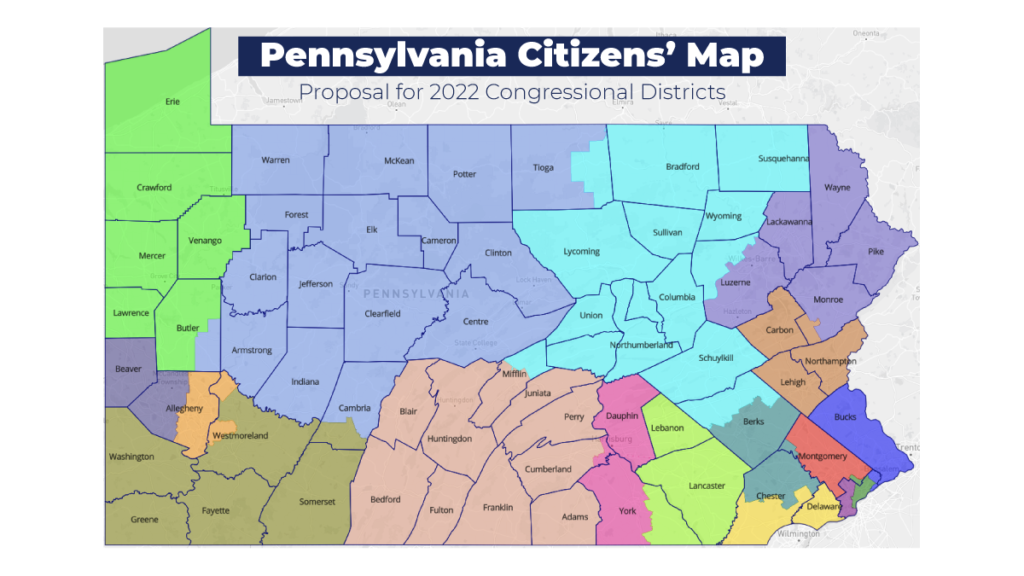By: Jacob Schramm, Staff Writer

Following the recent decision nullifying a no-excuse mail-in voting law,[1] and for the second time in three election cycles, the Pennsylvania Supreme Court will resolve the ongoing dispute on Congressional redistricting.[2] The process of adopting a new Congressional map started with the 2020 census, but has now forced the Court to suspend the General Primary Election calendar delaying the petition process for hopeful candidates in the November election until the issue is resolved.[3]
Article 1, section 2 of the Constitution states that Congressional representatives are to be apportioned based on a state’s “respective numbers,” counted and updated by the decennial census.[4] The Constitution initially held that no district should exceed 30,000 people, and the Founders envisioned that the number of representatives would continue to grow as the population expanded.[5] However, in 1929 Congress fixed the permanent number of representatives at 435 and since then the states have engaged in regular updates to their representative map to properly reflect their “respective numbers.”[6] Each state must establish a representative map through their own adopted mechanisms, often creating a contentious partisan landscape.
Pennsylvania’s Constitution provides that this process is accomplished by a Legislative Reapportionment Commission, formed after the census, and consisting of the four leaders from the majority and minority parties or their appointed deputies.[7] Collectively they choose an impartial fifth member and submit a preliminary plan to their elections officer, who must hear an appeal from any “aggrieved person.”[8] The Commission then makes any changes and submits a final plan. Appeals are heard by the Supreme Court, who may either remand or issue a final and binding order implementing a map.[9] The PA Commission was formed in March 2021 and, following a deadlock, asked the PA Supreme Court to select their fifth member.[10] The Commission held public hearings throughout the summer, considering the testimony of many representative groups.[11] The Commission began accepting public map submissions in October, offering a digital platform for citizens to craft map proposals online.[12] On December 16 the Commission adopted the map submitted by Amanda Hoult, a PA citizen with a background in district-drawing.[13] While subsequently adopted by both the Assembly and Senate, Governor Wolf vetoed the map and responded with an invitation for public negotiations.[14] With the earliest election deadline set for February 15, and in response for an emergency application for emergency relief, the Supreme Court stepped to reach a final decision.
The Court has weighed in on the question of districting as recently as 2018. In League of Women Voters v. Commonwealth (“LWV”), the Court substituted their map in the place of the 2011 districting plan, finding it violated the Free and Equal Elections Clause of the PA Constitution because it diluted the power of Democrats to elect representatives by concentrating power into the hands of historically Republican voters.[15] The Court reached this conclusion through the judgment of three standards in drawing districting maps: (1) that the population of the districts is equal to the extent possible; (2) that the districts created are comprised of “compact and contiguous geographical territory”; and (3) that the districts represent the boundaries of existing political subdivisions contained therein.[16] In the resulting election using the newly-adopted map, Democrats flipped four seats and Republicans flipped one, resulting in a 9-9 tie in state representation.[17]
Responding to an order from the PA Supreme Court for a recommendation as “Special Master” on the issue, Commonwealth Judge Patricia McCullough found that, of the over a dozen plans that the Court is now considering, nearly all of them comport with the LWV standards.[18] She thus considered additional standards set forth in Mellow v. Mitchell allowing slight departures from mathematical perfection to “advance the cause of [electoral] equality,” the implications of the Voting Rights Act, and a general policy of deference to the legislature.[19] She ultimately recommended Hoult’s map as meeting all of the necessary prerequisites.
While the map’s proponents agree with Judge McCullough’s opinion, critics like Governor Wolf have said that it “fails the test of fundamental fairness.”[20] Continuing a trend of decline since 1933, Pennsylvania’s loss of another Congressional seat has made the fight over the valuable remainder even more contentious.[21] The state should strive to avoid the decade-long battle over the 2011 map which, based on LWV, resulted in 10 years of malapportioned representation. At the time of this writing, the Supreme Court is set to hear arguments on February 18 and, regardless of their sense of the outcome, candidates, campaigns, and partisan groups must quickly spring to action to mobilize towards the November election.
[1] https://www.spotlightpa.org/news/2022/01/pennsylvania-mail-voting-unconstitutional-supreme-court-appeal/
[2] See https://www.pubintlaw.org/cases-and-projects/pa-supreme-court-adopts-new-congressional-map/
[3] https://www.pacourts.us/assets/opinions/Supreme/out/7mm2022pco%20-%202-9-2022.pdf#search=%22petition%20election%22
[4] https://billofrightsinstitute.org/primary-sources/constitution?gclid=Cj0KCQiAmKiQBhClARIsAKtSj-njU7KoP4ALvdpDxsBm7eT48zxKLD45LSemAXWHvFEz_HVRhJh0vNEaAuUYEALw_wcB
[5] https://avalon.law.yale.edu/18th_century/fed58.asp
[6] https://www.census.gov/history/www/reference/apportionment/apportionment_legislation_1890_-_present.html
[7]https://www.legis.state.pa.us/cfdocs/legis/LI/consCheck.cfm?txtType=HTM&ttl=00&div=0&chpt=2&sctn=17&subsctn=0
[8] Id.
[9] Id.
[10] https://www.redistricting.state.pa.us/resources/press/Commission%20Letter%20to%20Supreme%20Court%20(005).pdf
[11] https://www.redistricting.state.pa.us/resources/press/2021-05-03%20Supreme%20Court%20appoints%20Mark%20Nordenberg.pdf; https://www.redistricting.state.pa.us/commission/#news
[12] https://www.redistricting.state.pa.us/commission/article/1081
[13] https://www.redistricting.state.pa.us/commission/article/1086
[14] https://www.governor.pa.gov/newsroom/governor-wolf-responds-to-congressional-redistricting-map-proposed-by-the-house-state-government-committee/
[15] 645 Pa. 1 (2018).
[16] Id. at 119.
[17] https://www.politico.com/election-results/2018/pennsylvania/
[18] https://www.pacourts.us/Storage/media/pdfs/20220207/174445-feb.7,2022-specialmaster’sreportwithproposedfindingsoffactandconclusionoflaw.pdf
[19] Id.
[20] https://www.governor.pa.gov/wp-content/uploads/2022/01/20220126-HB-2146-Veto-Message.pdf
[21] See https://history.house.gov/Institution/Apportionment/Apportionment/, “Apportionment by State (PDF).”